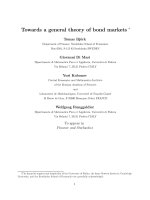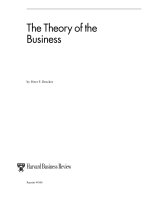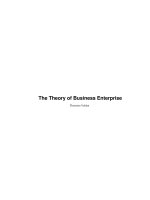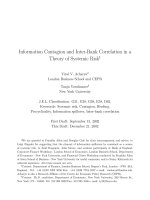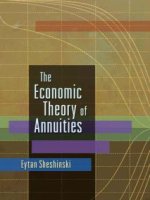Class 1 reference 1 lewis theory of development
Bạn đang xem bản rút gọn của tài liệu. Xem và tải ngay bản đầy đủ của tài liệu tại đây (3.26 MB, 4 trang )
Principles and Concepts
two prominent examples of r,vhat emerged 4s nainsf'eam Western theories of
development during the 1970s: the theoretical and empirical models of stuctr:ral
change.
Structural-Ghange Models
Sfircftral-e,hange theory focuses on the mechanism by whicl underdeveloped
economies transform their domestic economic stmctures from ahea'lry emphasis
on taditional subsistence agriculture to a more modern, more urbanized, ?Dd
more industially diverse manufacturing and service economy. It employs the
tools of neoclassical price and resource allocation theory and modem econometrics to describe fuow this transformation process takes place. Tlvo well-hown representative exarnples of the sEmctural-change approach are the "two-sector surplus labor" theoretical model of W. Arttnr Lewis a.nd the "patterns of development" empirical analysis of Hollis B. Cheuery..
One of the best-hrown early theoretical models of development that focrrsed on
the stnrctural transformation of a primari$ subsistence economy was that formulated by Nobel laureate W. Artturr I€wis in the mid-1950s and later modified,
foruralized, dDd extended by Ionn Fei and GusUv Ranis'The Lerilis two-sector
model became the general theory of the development process in surplus-labor
Third World nations dr:ring most of the 1960s a:rd early 1970s. It still has many
adhereats today, especially among American development economists.
In the I€wis model, the r:nderdeveloped econorDy consists of two sectors: a traditional, overpopulated n:ral subsistence sector characterized by zero marginal
labor productivity-a situation that permits I€wiE to dassify this as surplus labor
in the sense that it can be withdrawn from the agriailtural sector without anyloss
of output-and a high-productivity modem r.uban industrial sector into which
labor from the subsistence sector is gradually traasferred- The primary focus of
the model is on both the process of labor tansfer and the gronrttr of output arrd
employrrent in the modern sector. Both labor transfer and modern-sector
emplqrmeat growth are brought about by ouput expansioa in that sector. The
speed with whidr this srpansion occurs is determined by the rate of indusuial
invesEent and capital accurnulation in the modem sector. Such investment is
made possible by the excess of modern-sector profits over wages on the assumption that capitalists reinvest all their profits. Finally, the level of wages in the urban
industrial sector is assr:med to be coDstant and determined as a given premir:m
over a fixed average subsistence level of wages in the uaditional agriculnral sector. (Icwis assumed that urban wages would have to be at ieast 30% higher thaa
average n-rral income to induce workers to migrate ftom their home areas.) At the
constant r.ubanwage, the supply curve of rural labor to the modern sector is considered to be perfectly elastic.
Theories of Development A Comparative Analysis
Figure 3.1 The Lewis Model of Modem-sector Growth in aTwo-Sec;tor
Surplus-Labor Economy
implicit and explicit
PrKJr) =wuq
độ dốc
Quantityof labor (Qad (millions)
(a) Modera (indusuial) sector
(bl Traditional (agriolnual) sector
We can illustate the Leuris model of modern-sector growth in a two-sector
economy by using Figr:re 3.1. Consider first the eaditional agricultr:ral sector portrayed in the h^ro right-side diagrams of Figure 3.1b. The upper diagram shows
how subsisteace food production varies with increases in labor inputs. It is a
typical agriculnual production functiou udrere the total output or product (7P) of.
food is determined by changes in_the amount of the onlyvariable input, labor (IJ,
given a fixed quantity of capital, Kr, a::d nnchanging traditiond tecbaoloTy, fe.h
the lower rigbt diagram, we have the average a.od mar$nat product of labor
curves, ,APu atd IyDu, rrytrich are derived from the total product curye shoum
Principles and Concepts
Theories of Development A Comparative Anatysis
to the area of the rectaagle OWMFLL.The balance of the output shown bythe area
Wr4F would be the total profits that accrue to the capitalists. Because Lewis
assumes that aII of these profits are reinvested, the total capital stock in the modern sector will rise from Ky1 to KM.This larger capital stock causes the total product curve of the modem sector to rise to TPL{KM!), rivhich in tum induces a rise in
the marginal product demand curve for labor. This outward strift in the labor
demand curve is shor,rrn by line Dz(Kw) in the bottom half of Figure 3.1a- A new
equilibrium modern-sector employment level will be established at point Gwith
^[, workers now employed. Total ouput rises to TPpor oDrGl..while total wages
and profits increase to OWMGkandWnDrG, respectivety. Once again, these larger (WnaDrQ profits are reinvested, increasing the total capital stock to K,o, shifting
the total product and labor demand curves to TP^lKofi aad to D3Kd, respectively, and raising the level of modern-sector smplolmlent to.t€.
This process of modern-sector self-sustaining grorvth and emplo-5pent exparsion is assrr:ned to continue r:ntil all surplus nrral labor is absorbed in the new
industial sector. Thereafter, additional workers can be withdrawn from the agricultural sector only at a higher cost of lost food production because the declining
labor-to-land ratio rtreans that the marginal product of rural labor is no longer
zero. Thus the labor supply fluve becomes positively sloped as modern-sector
wages and smplolanent continue to gow. The stnrctural transformation of the
economy will have taken place, with the bdance of economic activity shifting
from traditional nual agriculture to modern urba:r industry.
Crtficisms of the Lewis Model
Although the Lewis two-sector development model is simple and roughly reflects
*re historical experience of economic growth in theWest, three of its key assumptions do not fit the instiflrtional and economic realities of most contemporary
developing cor-rntries.
First, the model implicitly assumes that the rate of labor Ea-nsfer and employrnent creation in the modem sector is proportional to the rate of modern-sector
capital accr:mr:Iation The faster the rate of capital accnmulation, the higher the
growth rate of the modem sector and the faster the rate of new job creation. But
what if capitalist profits are reinvested in rrrore sophisticated laborsaving capital
equipment rather than just duplicating the existing capital as is implicitly
assumed in the t€wis model? [We ale, of course, here accepting the debatabte
assumption that capitalist profits are in fact reinvested in the local economy and
not sent abroad as aform of "capital flight" to be addedto the deposits ofWestem
barrks!) Figure 3.2 reproduces the lower, modem-sector diagram of Figr:re 3.1a,
onlythis time the labor demand curyes do not shift uaiformly outward but in fact
cross. Demaad curye Dz(Ku) has a greater negative slope than Dz(Kaa) to reflect
the fact that additions to the capital stock embody laborsaving technical
progress-that is, .X?V/, technology requires much less labor per r.rnit of output tharr
.tful, technolory does.
We see that even though total output has grown substantiaily (i.e., OD=EL,, is
significantly greater than ODTEL,), total wages (OWMELL) and employnent (Ir)
remain uachanged. AIl of the e)(m. outPut accrues to capitelists in the fonn of



